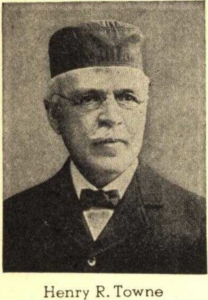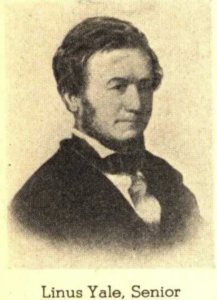Note: The following is a republished excerpt from The Yale and Towne Manufacturing Company’s Catalog No. 29. We have made no changes to this excerpt and what you see is exactly how it was printed in 1939, albeit in a different medium.
NEARLY a century ago, in the little village of Newport, N.Y., about twelve miles northeast of Utica, the name Yale was first identified with locks. It was there that Linus Yale, Senior, started as a lock maker and produced the Yale Bank Lock, the first of the long and varied line of locks to bear that famous name.
Linus Yale, Senior, had a natural genius for mechanics which he first devoted to originating improvements in various milling devices. Later he turned to designing and making bank locks which, in those days, were of intricate construction and always operated by keys. He also made a number of locks for use on doors, drawers and other places, all of high mechanical excellence.
In 1847, the same year in which he brought out the Yale Bank Lock, which was considered a masterpiece of ingenuity, he built in Newport, N.Y., a substantial stone building to serve as his factory. That building was known in that community as the “Yale Lock Shop.”

Linus Yale, Junior, his son, born in Salisbury, N.Y., in 1821, began his career as an artist. Soon, however, he inherited mechanical aptitude manifested itself and he followed his father’s footsteps as a designer and maker of locks. Although father and son were never in partnership, the younger Yale’s first essays in the field were in his father’s factory at Newport, N.Y. About 1855 Linus Yale, Junior, moved to Philadelphia and started in business for himself. Later he moved to Shelburne Falls, Mass.
Like his father, Linus Yale, Junior, first devoted himself to the design and manufacture of bank locks. Among them was the first Yale Monitor Bank Lock which marked the transition from key locks to dial or combination locks. Later he began to apply his talents to the improvement of small locks for general uses. He employed “pin-tumblers” embodying the principle used thousands of years ago in Egypt, but by him skillfully adapted to modern conditions and needs. He also designed and developed the “metallic front” for Post Office lock boxes.

In 1868, Linus Yale, Junior, formed a partnership with Henry R. Towne, which resulted in the organizing in October, 1868, of the Yale Lock Manufacturing Company. They erected a modest factory at Stamford, Conn. Unfortunately Linus Yale, Junior, died suddenly in New York (on Christmas Day, 1868) before the venture had been fully launched upon its career.
Mr. Towne at once became the active head of the Company, the first corporate name being The Yale Lock Manufacturing Company, which was later changed to The Yale & Towne Manufacturing Company. Until 1915 Mr. Towne continued to serve as President when, after 46 years in that position, he resigned to become Chairman of the Board, which position he occupied until his death in 1924. To his remarkable ability, both as an engineer and as an executive, and to his energy, foresight and integrity, the rapid but sound growth of the Company was largely due.
Today the plant of the Stamford Division occupies 25 acres, has 68 buildings and over 1,000,000 square feet of floor space.
During the years, The Yale & Towne Manufacturing Company has branched out into the manufacture of many other products in addition to locks and hardware. The Company is today a leader in the design and manufacture of various types of materials handling equipment. Yale Chain Hoists and Electric Hoists, Trolleys, Electric Trucks and Hand Lift Trucks are serving industry throughout the world with outstanding efficiency and economy.
To meet the demands of this expansion, other divisions have been added to the Company in the United States and abroad.

